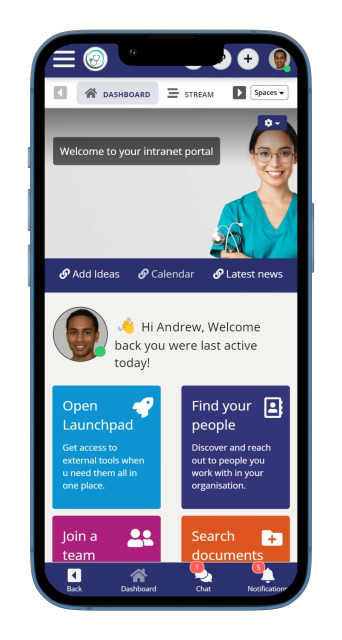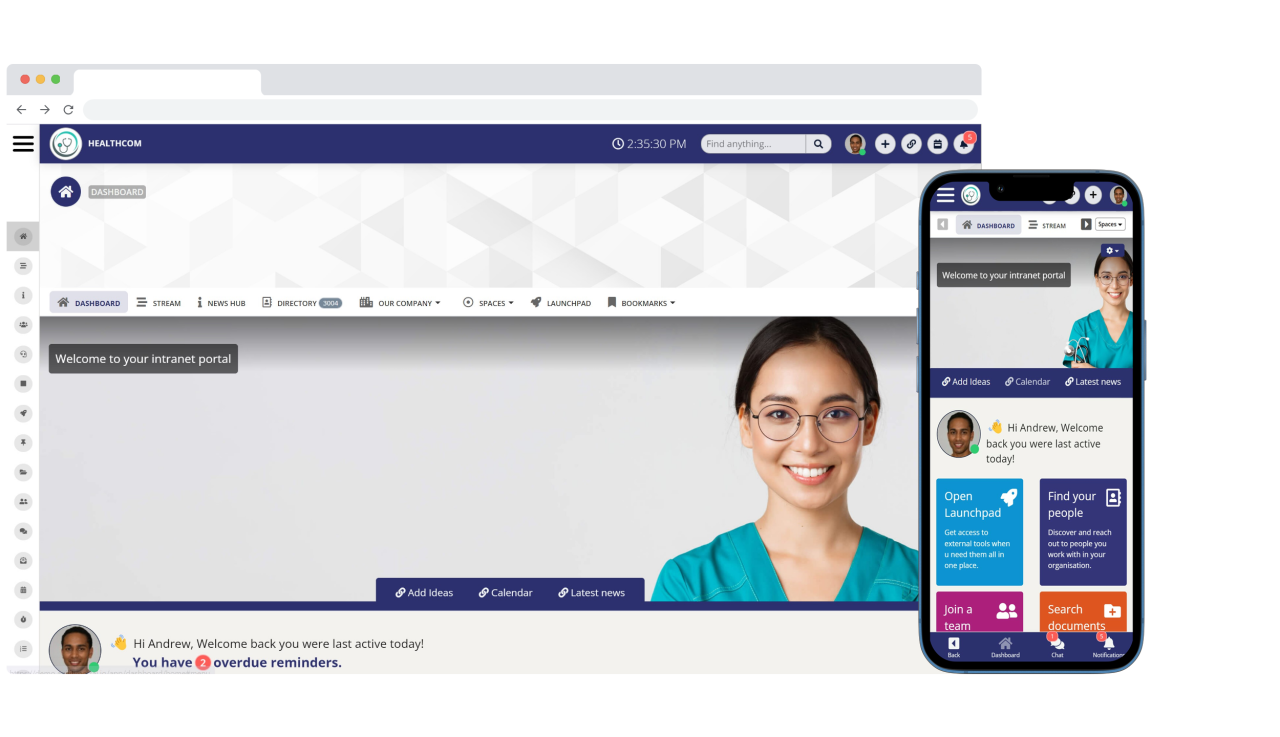Insight Blog
Agility’s perspectives on transforming the employee's experience throughout remote transformation using connected enterprise tools.
17 minutes reading time
(3318 words)
Internet Intranet Extranet: Key Differences
Internet, intranet, extranet: Which one is best for your organization? Learn the differences to select the right platform for your organization's success.
Internet, intranet, extranet - grapefruit, orange, lemon - what's the difference?
Every network here symbolizes a unique network pattern, and each has its in-built security attributes and suitability in the business sphere.
Thus, it is imperative to draw a line between them so that you don't expose the trade secrets of your organization. Knowing the specifics of each network kind is a sure way of keeping your assets safe and secure as well as making sure they are put in the right place.
Intranet vs Internet: Key Differences
Intranet is an internal network that allows access only for the members of the organization.
It is a restricted domain network that is essentially for sharing files and information with an adequate level of confidentiality within an organization. Contrary to this, the internet is a wide array of computer systems networking known as the internet which is accessible by anyone worldwide.
The key difference between intranet and internet is that the internet, also known as World Wide Web (WWW), is a global network of interconnected computer networks, while intranet is a local network or an organization's local internal network.
An internet is a public network that can be accessed by any user but it is not the case when it comes to intranet.
Extranet vs Intranet: Key Differences
Now lets get in to the difference between intranet and extranet , an intranet is a private network that can be used only by a company or organization and it can be accessed by its employees only.
The internal communication system which is compact in nature facilitates collaboration, interaction and information dissemination within the corporate structure. It's designed in accordance with requirements of the organization and security protocols that the business may have.
This helps to keep safe intellectual property and other sensitive company information. Intranets may be home to many things like document management systems, internal messaging platforms, project collaboration apps, and much more. These tools are used to speed up processes and make operations more effective.
The intranet works well for this purpose as it is only accessible to employees and is thus critical for preserving confidential data.
This type of environment gives the employees larger control over their working space and makes the use of resources available while ensuring the safety of the employees and information.
Internet vs Intranet vs Extranet
Extranets share a common ground with networks in the sense that their access is restricted to selected parties, such as vendors and consumers, through an authorized protocol.
Unlike public networks, extranets are the only ones that create a platform to share insensitive specific data with the partners which are trusted.
Such a collaborative space can be used for planning the supply chain, customer relationship management and partner interacting. An extranet extends its internal intranet to the external part and ensures that the exchange of data occurs securely and effectively.
This selective sharing is under the watchful control and maintained by tight security systems and protocols that only allow those who are authorized to view or interact with the shared data. It is a strategic tool for businesses to improve and assess their external partnerships while maintaining internal control over the information.
The application of extranets allows businesses to simplify their operations and establish stronger business relationships with external partners through better communication and collaboration.
Follow us and access great exclusive content everyday: Follow us on Google News
Why companies use intranet
For some, the term "intranet" may evoke outdated notions of cumbersome file management systems overseen by an elusive IT department. However, contemporary mobile intranet solutions play a vital role in ensuring businesses remain secure, efficient, and interconnected, particularly in the era of increasingly prevalent remote work.
In specific scenarios, frontline workers or remote teams may require access to secure information, such as customer order details, financial reports with the accounting team, or collaboration on new product development.
In all these instances, a controlled private network or mobile intranet application can facilitate productivity while safeguarding customer data.
Here are several ways a modern employee intranet can benefit your company:
- Streamlined knowledge management: Securely store and share critical documents essential for all employees, including frontline workers and remote teams.
- Network security: Leading intranet software and web servers offer an added layer of security to connected devices and their data. While internet firewalls protect connected computers, private servers secure intranet connections, ensuring only authorized individuals can access the network.
- Enhanced internal communications: Utilize a secure intranet to disseminate company-wide updates and facilitate interaction among all employees.
- Increased productivity and collaboration: Modern intranets enable teams to communicate effectively and collaborate on projects through private messages and threads within a secure network.
Contemporary company intranet solutions like AgilityPortal provide features such as activity feeds, private messaging, and mobile applications to keep employees connected.
Additionally, these solutions offer user activity tracking and workforce insights to gauge employee engagement effectively.
Why companies use extranet
Companies utilize extranets to grant customers or vendors access to secure information, facilitating sharing and collaboration with them. For instance, if you have a customer who regularly places orders with your business, setting up a secure extranet allows them to update orders, process invoices, and communicate with your team seamlessly.
Extranets play a crucial role in robust data management strategies by enabling businesses to share information with trusted partners and customers while maintaining security. Apart from facilitating secure collaboration and communication, extranets aid organizations in complying with data-sharing regulations such as GDPR.
For those seeking a dependable method to share sensitive data with customers or vendors, leveraging digital tools that support secure extranet access is advisable. With the appropriate configuration, you can effortlessly share information with customers and ensure compliance with data regulations.
Specific instances where a frontline organization may require an extranet platform include:
Extranets play a crucial role in robust data management strategies by enabling businesses to share information with trusted partners and customers while maintaining security. Apart from facilitating secure collaboration and communication, extranets aid organizations in complying with data-sharing regulations such as GDPR.
For those seeking a dependable method to share sensitive data with customers or vendors, leveraging digital tools that support secure extranet access is advisable. With the appropriate configuration, you can effortlessly share information with customers and ensure compliance with data regulations.
Specific instances where a frontline organization may require an extranet platform include:
- Sharing financial data with auditors and key stakeholders.
- Providing customer support through a help desk.
- Collaborating on product development with engineering teams.
In all these scenarios, an extranet solution enhances productivity and alignment with partners.
You may also like: Best Apps for Employees: UPDATED 2022 – A Complete Guide
Why companies use internet
Beyond its conventional use for browsing and emailing, the internet serves as a vital infrastructure for numerous crucial functions within companies. Many businesses heavily rely on cloud-based software to streamline operations and manage employees, necessitating a stable internet connection for seamless access.
Moreover, deskless teams often require consistent internet access to engage with specific web portals essential for communication with vendors and clients. Frontline workers, too, depend on internet connectivity to retrieve essential business data, such as customer databases and product manuals, crucial for their daily tasks.
Consider scenarios where companies heavily rely on internet solutions:
Moreover, deskless teams often require consistent internet access to engage with specific web portals essential for communication with vendors and clients. Frontline workers, too, depend on internet connectivity to retrieve essential business data, such as customer databases and product manuals, crucial for their daily tasks.
Consider scenarios where companies heavily rely on internet solutions:
- Enabling remote work: With the rise of remote work arrangements, companies require internet solutions to ensure employees can access company resources, collaborate with colleagues, and participate in virtual meetings from anywhere.
- Online customer service: Companies often utilize internet solutions to provide customer support through various online channels such as live chat, email, or social media platforms, allowing for prompt assistance and issue resolution.
- E-commerce operations: Businesses that engage in online retail rely heavily on internet solutions to manage their e-commerce platforms, process online transactions securely, and provide a seamless shopping experience for customers.
- Data management and storage: Companies depend on internet solutions for cloud-based storage and data management systems, enabling convenient access to critical business data and facilitating collaboration among team members.
- Digital marketing and advertising: Internet solutions are essential for companies to execute digital marketing campaigns, manage online advertising platforms, and analyze customer engagement metrics to optimize marketing strategies effectively.
- Virtual communication and collaboration: Organizations require internet solutions to facilitate virtual communication and collaboration among employees, partners, and clients through video conferencing, project management tools, and shared online workspaces.
- Research and development: Companies engaged in research and development activities rely on internet solutions to access online databases, conduct market research, and collaborate with external stakeholders to innovate and develop new products or services.
- Compliance and regulatory requirements: Many industries have regulatory obligations related to data privacy, security, and reporting, necessitating internet solutions for ensuring compliance with legal requirements and industry standards.
- Supply chain management: Internet solutions play a crucial role in supply chain management by enabling real-time tracking of inventory, managing supplier relationships, and coordinating logistics operations efficiently.
- Employee training and development: Companies utilize internet solutions to deliver online training modules, educational resources, and professional development programs to employees, enabling continuous learning and skill enhancement.
What are the differences between the internet, an intranet and an extranet?
| Feature |
Internet |
Intranet |
Extranet |
| Accessibility |
Public |
Private |
Semi-private (restricted access) |
| Purpose | Global communication and information access | Internal communication and collaboration | Communication and collaboration with external parties |
| User Base | General public, worldwide | Employees within the organization | Employees, customers, suppliers, partners |
| Access Control | No access control | Restricted access controlled by organization | Restricted access for authorized external parties |
| Content | Wide range of publicly available information | Company-specific information and resources | Shared information with external parties |
| Security | Limited control over security measures | Controlled access with security protocols | Controlled access with security protocols |
| Collaboration | Limited collaboration features | Robust collaboration tools for employees | Collaboration features for external parties |
| Communication | Open communication channels | Internal communication channels | Communication channels with external parties |
This table provides a comprehensive overview of the key differences between the internet, an intranet, and an extranet, focusing on accessibility, purpose, user base, access control, content, security, collaboration, and communication features.
Key Benefits Of Intranets and Extranets
Implementing an intranet system can significantly enhance a company's operational efficiency and workforce effectiveness. It serves as a centralized hub, streamlining access to crucial online resources essential for employees' daily tasks.
This includes cloud-based software, company policies, training materials, and other relevant documentation. By simplifying resource accessibility, intranets contribute to heightened productivity levels within the organization.
Moreover, intranets foster improved collaboration among colleagues by facilitating seamless communication channels. Utilizing features such as discussion forums, social media platforms, or internal newsletters, employees can exchange ideas, share updates, and collaborate on projects more efficiently. This streamlined communication process minimizes the time and effort required to complete tasks, thus enhancing overall productivity.To efficiency gains, intranets prioritize security by implementing access controls and encryption protocols. By restricting access to sensitive information, intranets provide a secure platform for internal communication and data exchange. This ensures that confidential company data remains protected from unauthorized access or breaches.
On the other hand, extranets serve as valuable tools for facilitating interactions between a company and its external stakeholders. These platforms enable seamless communication and collaboration with external parties such as customers, suppliers, and partners.
Extranets grant these stakeholders controlled access to specific information, documents, and data, fostering transparency and facilitating smoother business interactions.
Extranets contribute to increased productivity by equipping external parties with the necessary tools and resources to engage effectively with the company. Whether it's accessing product information, submitting orders, or collaborating on projects, extranets streamline external operations and enhance overall efficiency.
From a secruity standpoint extranets prioritize security by providing secure communication channels and data exchange platforms for interactions with external parties. By implementing robust authentication measures and encryption protocols, extranets ensure the confidentiality and integrity of sensitive information shared with external stakeholders.
So in a nutshell, intranets and extranets serve as invaluable tools for optimizing internal and external communication, collaboration, and productivity within companies.
Extranets contribute to increased productivity by equipping external parties with the necessary tools and resources to engage effectively with the company. Whether it's accessing product information, submitting orders, or collaborating on projects, extranets streamline external operations and enhance overall efficiency.
From a secruity standpoint extranets prioritize security by providing secure communication channels and data exchange platforms for interactions with external parties. By implementing robust authentication measures and encryption protocols, extranets ensure the confidentiality and integrity of sensitive information shared with external stakeholders.
So in a nutshell, intranets and extranets serve as invaluable tools for optimizing internal and external communication, collaboration, and productivity within companies.
By leveraging these platforms effectively, organizations can streamline operations, enhance security, and foster stronger relationships with both internal teams and external stakeholders.
Can Companies Use Internet-hosted Platforms?
Besides the apparent internet use for everyday activities such as browsing and emailing, many companies rely on the internet for the critical employee functions. For example, most businesses these days operate on the cloud, using it to run their business and manage employees, and most of this cloud software requires an internet connection.
Anonymous workers may require a functioning website portal that allows them to effectively communicate with the site's visitors and customers.
A frontline employee may also use the internet to find essential business information including customer databases or product manuals.
Free ebook: How To Get Your Intranet Off The Ground
Internet, Intranet, or Extranet: Which one is Right for You?
Organizations have both intranets and extranets to remain connected and productive but which of them will best suit your precise situation?
If you are aiming for a solution that enables the safe and user-friendly management of information with customers or suppliers, you must go for an extranet. On the one hand, if the issue is the need to connect dispersed workers or desktop teams, then an intranet may be a better option.
Before selecting the solution for your organization, you should reflect on the needs of your staff and customers. For instance, if you work in a project with multiple partners or vendors distributed in different locations, an extranet might be the most appropriate solution.
It is also very important to think about the wider organizational objectives of the company.
Do you want to achieve higher employee engagement and retention levels by upgrading the communication and collaborative standards? If that is the case, an intranet or an employee engagement tool could be the best option.
If you are looking at an online platform to cater more outbound and customer-centered, extranet platform is the option.
How Can an Intranet Help Your Business
Employee applications represent the contemporary evolution of the intranet, serving as a digital platform for streamlined and instantaneous communication within a company.
Utilizing an employee app can yield various benefits for your business, including:
1. Enhancing Communication Efficiency
Employee apps serve as a centralized communication platform for both employees and management, thereby reducing instances of miscommunication, enhancing operational efficiency, and fostering better collaboration.
Moreover, with AgilityPortal, managers gain the ability to effortlessly create and publish schedules, while employees can access their schedules in real-time, request shift changes or swaps, and receive timely shift reminders.
This functionality significantly reduces scheduling conflicts and ensures adequate shift coverage.
AgilityPortal further offers an integrated smart time clock feature, aiding managers in compliance with labor laws and employment standards. For instance, the app facilitates the management of employee time off, tracks overtime hours, and ensures employees are not subjected to excessive workloads.
2. Enhancing Productivity Levels
Employee apps play a pivotal role in boosting productivity by granting employees seamless access to pertinent work-related information, including schedules, tasks, and deadlines. This accessibility ensures that workers remain organized and focused, resulting in heightened productivity levels.
Moreover, employee app functionalities, such as specialized task-related channels, employee mentions, task updates, comments, and push notifications, synergistically contribute to streamlining operations and enhancing overall efficiency within the workforce.
The incorporation of additional features, such as project management tools, task prioritization capabilities, and progress tracking functionalities, further empowers employees to efficiently manage their workload and meet project deadlines effectively.
This comprehensive suite of tools fosters a conducive environment for maximizing productivity and achieving organizational goals.
3. Fostering Employee Engagement
Employee apps serve as catalysts for enhancing employee engagement by providing colleagues with platforms to offer feedback, exchange ideas, and actively participate in various company initiatives.
These apps cultivate a sense of belonging among employees by facilitating open communication channels and encouraging collaboration across different levels of the organization.
To further bolster engagement, modern employee apps often integrate features such as employee recognition programs, virtual suggestion boxes, and interactive polls or surveys.
These additional functionalities not only encourage active participation but also contribute to creating a vibrant and inclusive company culture.
Overall, leveraging employee apps not only enhances engagement but also strengthens employee morale, loyalty, and overall satisfaction, thereby fostering a more productive and cohesive workforce.
4. Enhancing Training and Development Initiatives
Employee apps play a pivotal role in improving training and development by providing convenient access to online resources, e-learning modules, and various learning materials. This enables employees to continuously enhance their skill set and stay abreast of the latest industry trends and best practices.
For instance, AgilityPortal's employee training app offers a user-friendly platform for creating and delivering training materials. Utilizing a wide array of resources such as existing documents, PDF files, media, and web services like YouTube, Dropbox, Google Drive, or company websites, training content can be easily curated and disseminated to employees.
The integrated dashboard allows for efficient monitoring and tracking of each employee's training progress, course completion status, and proficiency level. This comprehensive oversight empowers managers to gain insights into individual performance metrics and identify areas for process improvement.
By leveraging employee apps for training and development initiatives, organizations can foster a culture of continuous learning and skill enhancement among employees, ultimately driving organizational growth and competitiveness in the ever-evolving business landscape.
5. Streamlining HR Operations
Employee apps play a vital role in simplifying HR processes by offering a range of features designed to automate various tasks and streamline administrative workflows. These features include recurring tasks, customizable digital forms and checklists, task automation, and communication channels tailored to specific tasks.
By leveraging these functionalities, employee apps facilitate the automation of HR processes such as leave requests, expense claims, and timesheets. This automation significantly reduces the administrative workload on HR personnel, enhances accuracy in data management, and promotes greater efficiency in HR operations overall.
For example, utilizing an employee app like AgilityPortal provides businesses with access to a diverse set of customizable features explicitly tailored to simplify and optimize their HR processes. From managing leave requests to processing expense claims, AgilityPortal empowers organizations to automate routine tasks, thereby freeing up valuable time and resources for more strategic HR initiatives.
In essence, employee apps serve as invaluable tools for modern HR departments, enabling them to streamline processes, improve operational efficiency, and focus on delivering enhanced employee experiences within the organization.
Use the power of the AgilityPortal's intranet software to improve employee communications and workflow
Looking for an intranet solution to boost employee engagement and streamline your organizational workflow?
Look no further! With modern intranets, you get the best of both worlds – seamless integration with the internet and extranet functionalities, all in one powerful platform.
Take AgilityPortal, for example. Our intranet software offers top-notch security measures to safeguard your company's sensitive information, ensuring only authorized personnel have access. Plus, with all your documents centralized in one platform, your team can easily access the resources they need to excel.But that's not all. With AgilityPortal, your employees benefit from enhanced collaboration tools, enabling seamless teamwork even when working remotely. Plus, our platform provides access to expert-verified information, empowering your team to tackle tasks with confidence and efficiency.
Don't settle for less – choose AgilityPortal for a comprehensive intranet solution that takes your employee engagement and workflow optimization to the next level!
Try AgilityPortal 100% free for 14 days now. No credit card required.
Wrapping up
To summarize, the key distinctions among intranet, internet, and extranet lie in their accessibility, purpose, and user base.
The internet serves as a public network accessible to all, whereas intranets function as private networks accessible solely to authorized users within an organization. Extranets, on the other hand, are private networks that grant external parties limited access to specific sections of an organization's intranet.
Intranets primarily serve internal communication, collaboration, and operations management purposes, whereas extranets facilitate external communication and collaboration with customers, suppliers, and partners.
Both intranets and extranets offer numerous benefits to organizations, including enhanced communication, collaboration, and cost-effectiveness.
In essence, comprehending the disparities among intranet, internet, and extranet is crucial for organizations seeking to harness these technologies to enhance their operations and maintain competitiveness in today's digital landscape.
Categories
Blog
(2600)
Business Management
(319)
Employee Engagement
(207)
Digital Transformation
(173)
Intranets
(119)
Growth
(118)
Remote Work
(61)
Sales
(48)
Collaboration
(37)
Culture
(29)
Project management
(29)
Customer Experience
(26)
Knowledge Management
(21)
Leadership
(20)
Comparisons
(5)
Ready to learn more? 👍
One platform to optimize, manage and track all of your teams. Your new digital workplace is a click away. 🚀
Free for 14 days, no credit card required.















